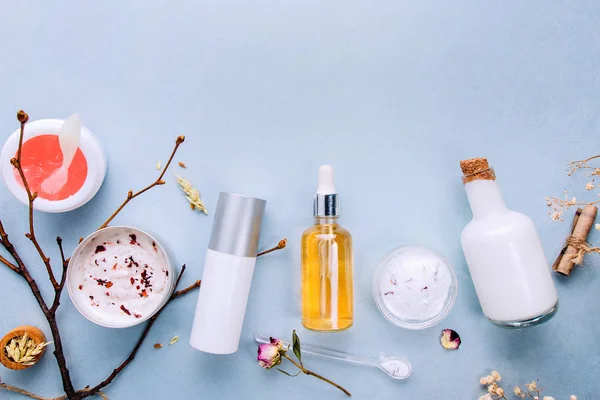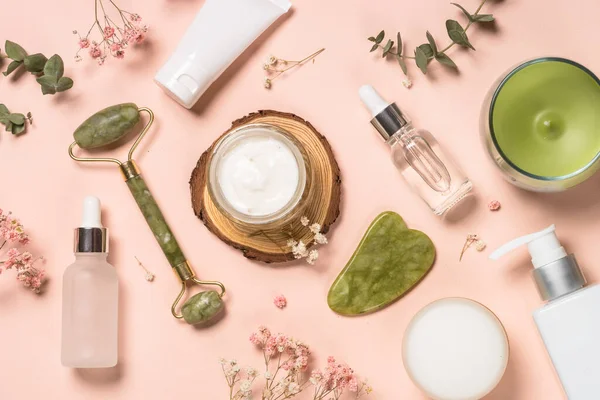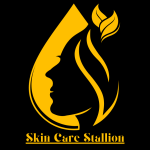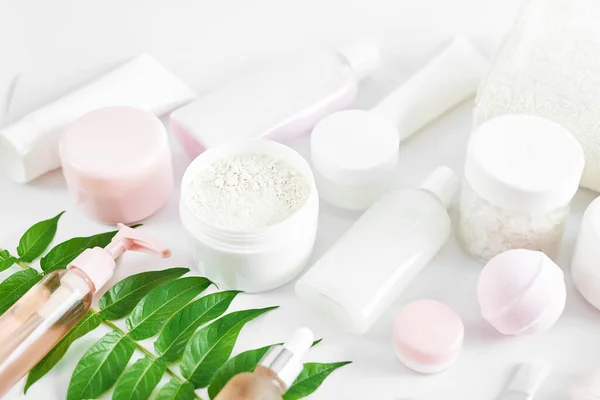Starting a skincare brand is like crafting a masterpiece from scratch, blending science, passion, and creativity into every bottle. In a world where beauty standards are constantly evolving, launching a skincare line offers a unique opportunity to make a lasting impact on the industry.
Whether you’re driven by a love for skincare, a desire to solve common skin concerns, or the ambition to create something truly exceptional, understanding the foundational steps is crucial. Here’s how to turn your skincare vision into a thriving brand that stands out in a crowded market.

How To Start A Skincare Brand
Researching the Market and Identifying Your Niche
Before diving into the development of your skincare products, it’s crucial to thoroughly research the market. Understanding current skincare trends, consumer demands, and potential gaps in the market can help you identify a unique niche.
Many aspiring skincare entrepreneurs start by analyzing successful brands, reading industry reports, and studying consumer reviews. This research will guide your product development and help you position your brand effectively.
Formulating and Testing Your Products
Once you’ve identified your niche, the next step is formulating your skincare products. Collaborating with a cosmetic chemist or a certified lab is vital to create safe, effective formulations.
Ingredients should be carefully selected based on your target audience’s needs, whether it’s anti-aging, acne treatment, or sensitive skin solutions
. Testing your products for safety and efficacy is a non-negotiable step. Many skincare brands conduct patch tests and clinical trials to ensure their products deliver promised results without causing adverse reactions.
Creating a Strong Brand Identity
A compelling brand identity is key to standing out in the crowded skincare market. Your brand’s name, logo, packaging, and overall aesthetic should reflect your values and appeal to your target customers.
Many successful skincare brands use storytelling to connect with consumers on a deeper level, sharing the inspiration behind their products and their commitment to quality. Branding also involves defining your brand’s voice and messaging, ensuring consistency across all marketing channels.
Navigating Regulatory Compliance
Skincare brands must comply with various regulations to ensure their products are safe and legally marketable. In the United States, for example, the FDA regulates cosmetics, requiring that products are properly labeled and free from harmful substances.
It’s essential to stay informed about the regulatory requirements in your target markets, as non-compliance can lead to legal issues and damage your brand’s reputation. Working with legal professionals who specialize in cosmetics can help you navigate these complexities.
Marketing and Launching Your Brand
The final step in starting a skincare brand is launching your products and promoting them to your target audience. Building a strong online presence through social media, influencer collaborations, and digital marketing is crucial in today’s market.
Many skincare brands also invest in content marketing, sharing educational content about skincare to build trust with potential customers. Pre-launch buzz can be created through teaser campaigns, exclusive offers, and partnerships with beauty influencers.
Starting a skincare brand is a challenging yet rewarding venture that requires careful planning, creativity, and a deep understanding of the skincare industry. By following these steps and staying committed to your brand’s vision, you can build a successful skincare brand that resonates with consumers and stands out in the market.
Market Research
Understa
nding the Skincare Industry
The skincare industry is vast and dynamic. It includes a wide range of products like cleansers, moisturizers, serums, and more. The global market is growing due to increasing consumer awareness and demand for quality skincare. Brands must understand product categories, consumer needs, and regulatory standards.
Current Market Trends
Staying updated with market trends is essential. Consumers are gravitating towards natural, organic, and sustainable products. Anti-aging, sensitive skin, and multi-functional products are also in high demand. Brands should focus on eco-friendly packaging, clean beauty, and inclusivity.
Target Audience Demographics
Understanding your target audience is crucial. Skincare consumers vary by age, gender, and skin type. For example, millennials often seek anti-aging and preventive products, while Gen Z prioritizes acne solutions. Identifying the right demographic helps tailor marketing strategies.
Competitor Analysis
Analyzing competitors provides valuable insights. It reveals their strengths, weaknesses, and market positioning. Study their product lines, pricing strategies, and customer reviews. This analysis helps in differentiating your brand and finding unique selling points.
Identifying Market Gaps
Market gaps present opportunities for innovation. Look for unmet consumer needs or underserved niches. This could be in terms of specific skin concerns, product formulations, or price points. Identifying these gaps can lead to successful product launches.
Niche Markets
Niche markets are growing rapidly. Organic, vegan, and cruelty-free products are gaining popularity. Anti-aging, sensitive skin, and gender-specific products also cater to specific consumer groups. Targeting these niches can create a loyal customer base.
Consumer Pain Points
Addressing consumer pain points is key to product development. Common issues include dryness, acne, sensitivity, and aging. Understanding these concerns helps in creating effective solutions that resonate with your audience.
Consumer Behavior and Preferences
Consumer behavior is influenced by various factors. Social media trends, influencer endorsements, and peer reviews play a significant role. Preferences also vary by region, with some markets favoring natural ingredients, while others prioritize advanced technology.
What Drives Purchases?
Purchases are driven by a mix of factors. Product effectiveness, brand reputation, price, and packaging all influence buying decisions. Emotional connections, such as trust in a brand or alignment with values, also drive purchases.
Popular Ingredients and Product Types
Certain ingredients and products are consistently popular. Hyaluronic acid, retinol, and vitamin C are widely used for their proven benefits. Cleansers, moisturizers, and serums are staples in skincare routines. Staying informed about trending ingredients helps in product development.
This overview provides a strong foundation for conducting comprehensive market research in the skincare industry. Understanding these elements will help in creating a brand that resonates with consumers and stands out in a competitive market.

Developing Your Brand Identity
Brand Vision and Mission
Your brand vision outlines where you want your brand to go. It’s the future you’re aiming to create. Your mission defines how you’ll get there. Both should reflect your core values and the impact you want to make.
Defining Your Brand Purpose
Your brand purpose is the reason your brand exists beyond making a profit. It’s about the change you want to see in the world. A clear purpose resonates with your audience and builds loyalty.
Crafting a Mission Statement
A mission statement is a concise summary of your brand’s goals, values, and how you intend to achieve them. It should be inspiring and align with your brand’s purpose and vision.
Brand Name and Logo Design
Your brand name is the first impression people have of your brand. It should be easy to remember and reflect your brand’s essence. A well-designed logo visually represents your brand and makes it instantly recognizable.
Importance of a Memorable Name
A memorable brand name sets you apart from competitors. It helps customers recall your brand quickly. A strong name can become synonymous with the product or service you offer.
Elements of an Effective Logo
An effective logo is simple, versatile, and relevant to your brand. It should be easily recognizable and work across various platforms and sizes. The right colors and fonts are crucial in conveying your brand’s personality.
Brand Story and Messaging
Your brand story connects with customers on an emotional level. It’s about sharing your journey, values, and what makes you unique. Consistent messaging reinforces your brand’s identity and builds trust.
Communicating Your Brand’s Unique Value
Highlight what makes your brand different. Clearly communicate your unique value proposition in all marketing materials. This sets you apart in a crowded marketplace.
Creating a Consistent Brand Voice
Your brand voice should be consistent across all channels. It reflects your brand’s personality and values. A strong, consistent voice helps build a recognizable and trustworthy brand identity.
Product Development
Formulating Your Products
Creating skincare products starts with formulation. Understanding the right blend of active ingredients is crucial. Each ingredient should address specific skin concerns like hydration, anti-aging, or acne.
Working closely with a cosmetic chemist ensures your formulation is both safe and effective. This collaboration helps in achieving the desired texture, scent, and performance.
Understanding Skincare Ingredients
Knowing your ingredients is key to a successful skincare line. Active ingredients like hyaluronic acid, retinoids, and vitamin C are popular choices.
These components must be carefully chosen based on their efficacy and how they interact with other ingredients. Ingredient sourcing, purity, and stability are also important considerations.
Working with Cosmetic Chemists
Partnering with an experienced cosmetic chemist is essential. They help translate your vision into a viable product. Chemists ensure that the formulation meets industry standards and regulations. They also assist in troubleshooting any formulation challenges, such as ingredient compatibility and stability.
Product Safety and Efficacy Testing
Testing is a critical step in product development. Safety tests ensure that products are safe for all skin types, including sensitive skin. Efficacy testing demonstrates the product’s effectiveness in addressing specific skin concerns. Both are necessary to build consumer trust and comply with regulatory requirements.
Product Line Strategy
Your product line strategy should reflect market needs and brand identity. Deciding on initial product offerings requires understanding current market trends and consumer demands. Balancing innovation with market demand ensures your products stand out while meeting customer expectations.
Deciding on Initial Product Offerings
Choosing your first products is a strategic decision. Start with essentials like cleansers, moisturizers, and serums. These products should address common skincare concerns such as hydration, anti-aging, and sun protection. Offering a mix of innovative and staple products can attract a broad audience.
Balancing Innovation with Market Demand
Innovation is important, but it must align with market demand. Stay updated on emerging trends and consumer preferences. Introducing new ingredients or formulations can set your brand apart. However, it’s crucial to ensure that these innovations resonate with your target audience.
Packaging Design
Packaging design plays a vital role in product appeal. Aesthetic and functional packaging enhances the customer experience. The design should reflect the brand’s identity and resonate with the target audience. Consider factors like ease of use, durability, and visual appeal.
Importance of Aesthetic and Functional Packaging
Packaging is not just about looks; it’s about functionality too. Aesthetic packaging attracts customers, while functional design ensures product usability. Consider packaging that protects the product from contamination and extends shelf life. Easy-to-use packaging improves customer satisfaction.
Eco-Friendly and Sustainable Options
Sustainability is becoming increasingly important in skincare. Eco-friendly packaging options, such as recyclable or biodegradable materials, appeal to environmentally conscious consumers. Incorporating sustainable practices in packaging design can enhance brand reputation and customer loyalty.




Thanks for sharing. I read many of your blog posts, cool, your blog is very good.